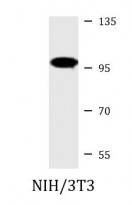ARG55616
anti-FER antibody
anti-FER antibody for Western blot and Mouse
Cell Biology and Cellular Response antibody; Signaling Transduction antibody
Overview
| Product Description | Mouse Monoclonal antibody recognizes FER |
|---|---|
| Tested Reactivity | Ms |
| Tested Application | WB |
| Host | Mouse |
| Clonality | Monoclonal |
| Clone | 1487CT794.8.50 |
| Isotype | IgG2a, kappa |
| Target Name | FER |
| Antigen Species | Mouse |
| Immunogen | Recombinant protein of Mouse FER. |
| Conjugation | Un-conjugated |
| Alternate Names | Fert2; p94-Fer; Fer; Fert; Tyrosine-protein kinase Fer; Proto-oncogene c-Fer; EC 2.7.10.2 |
Application Instructions
| Application Suggestion |
|
||||
|---|---|---|---|---|---|
| Application Note | * The dilutions indicate recommended starting dilutions and the optimal dilutions or concentrations should be determined by the scientist. | ||||
| Positive Control | NIH/3T3 |
Properties
| Form | Liquid |
|---|---|
| Purification | Purification with Protein G. |
| Buffer | PBS and 0.09% (W/V) Sodium azide |
| Preservative | 0.09% (W/V) Sodium azide |
| Storage Instruction | For continuous use, store undiluted antibody at 2-8°C for up to a week. For long-term storage, aliquot and store at -20°C or below. Storage in frost free freezers is not recommended. Avoid repeated freeze/thaw cycles. Suggest spin the vial prior to opening. The antibody solution should be gently mixed before use. |
| Note | For laboratory research only, not for drug, diagnostic or other use. |
Bioinformation
| Database Links | |
|---|---|
| Gene Symbol | Fer |
| Gene Full Name | fer (fms/fps related) protein kinase |
| Function | Tyrosine-protein kinase that acts downstream of cell surface receptors for growth factors and plays a role in the regulation of the actin cytoskeleton, microtubule assembly, lamellipodia formation, cell adhesion, cell migration and chemotaxis. Acts downstream of EGFR, KIT, PDGFRA and PDGFRB. Acts downstream of EGFR to promote activation of NF-kappa-B and cell proliferation. May play a role in the regulation of the mitotic cell cycle. Plays a role in the insulin receptor signaling pathway and in activation of phosphatidylinositol 3-kinase. Acts downstream of the activated FCER1 receptor and plays a role in FCER1 (high affinity immunoglobulin epsilon receptor)-mediated signaling in mast cells. Plays a role in the regulation of mast cell degranulation. Plays a role in leukocyte recruitment and diapedesis in response to bacterial lipopolysaccharide (LPS). Phosphorylates CTTN, CTNND1, PTK2/FAK1, GAB1, PECAM1 and PTPN11. May phosphorylate JUP and PTPN1. Can phosphorylate STAT3, but clearly plays a redundant role in STAT3 phosphorylation. Cells where wild type FER has been replaced by a kinase-dead mutant show no reduction in STAT3 phosphorylation. Phosphorylates TMF1. Isoform 3 lacks kinase activity. [UniProt] |
| Research Area | Cell Biology and Cellular Response antibody; Signaling Transduction antibody |
| Calculated MW | 95 kDa |
| PTM | Autophosphorylated. Polyubiquitinated; this leads to proteasomal degradation. |
Images (1) Click the Picture to Zoom In






